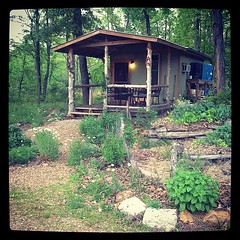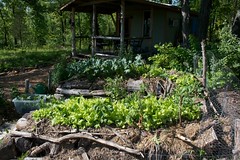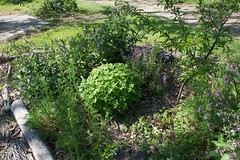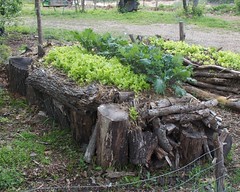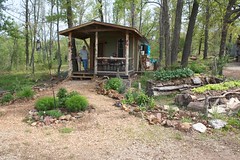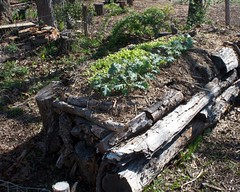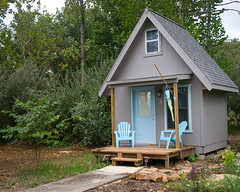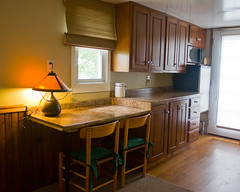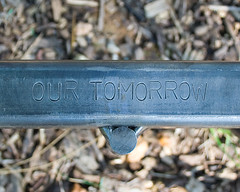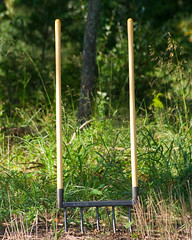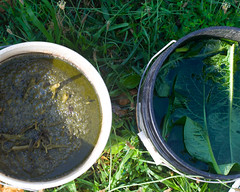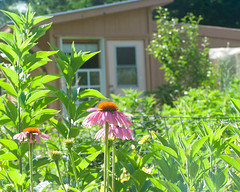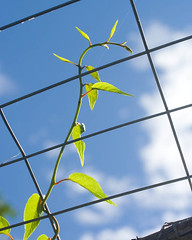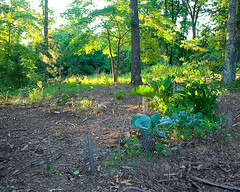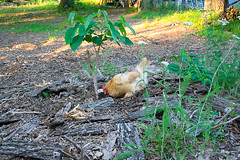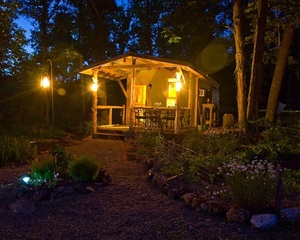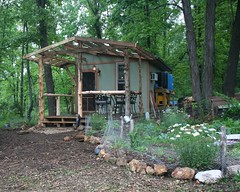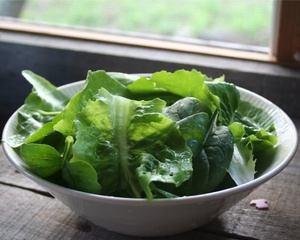Permaculture
Four years at the Homestead
The following spring we built the chicken coop greenhouse and in early summer we built the kids' cabin. The garden was expanded and more fruit trees were planted. The chickens arrived!! I also began work on the native wildflower Garden in front of my cabin. By the fall of 2009 I had begun to design and implement the various food forests. In addition to the fruit trees I added currants, gooseberries, paw paws, and a fairly large blueberry patch.
In May 2010 we added onto my cabin with a covered front porch and I finished my rain barrel installation. It was another hot, dry summer and I struggled to keep my garden alive. In the fall I began construction of my hugelculture beds. Another big fall project was trenching in our water line from the well house to our two main cabins. We also added onto our well house with a shower house and sleeping loft. Kerry and Greg's cabin was redesigned and the interior nearly finished.
2011 was a summer of refinements and revisions. We finished the interior of the shower house and out house. The interior if Kerry and Greg's cabin was finally finished as well. This was a laid-back summer, we swam a lot and I tried to keep the garden alive! The hugelculture beds performed fantastically.
That about sums it up. It has been a fantastic four years and this place is now my home, sweet home. I am looking forward to many more years here!
More Chickens!
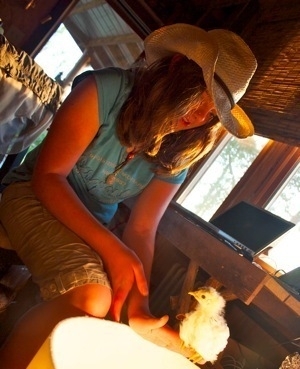
For some reason I never blogged it but back in April I'd gotten 5 new chicks to add to my flock of aging hens. I've only been getting 3-4 eggs a day so thought it was time to add in some new ones. In the past three months I've also lost some from the old flock, Boots the rooster was killed by some critter or maybe Chip (the original rooster) back in March. Then in July, the friendliest hen of the bunch, Waffle, died suddenly. In mid-August another hen died. All the others have been fairly healthy as far as I can tell. I sure hate to see them die.
Today, I decided to go ahead and let the new chicks mingle in with the older flock and so far it's been smooth sailing. I expect a bit of conflict but at 5 months the new girls are every bit as big as the older hens and should be able to take care of themselves. They'll figure out their new pecking order before too long.
Oh, they are Columbian Wyandotte, a very pretty breed, mostly white feathers but with a bit of black around the neck and tail that date back to 1893. Here's a shot from May with my niece Emma holding one in my cabin. I'd raised the Guineas back in the summer of 2009 but this is my first batch of chickens to raise. All the others had been raised by Kerry, Greg and the kids.
Based on my experience thus far it looks like I'll be adding 3-5 new hens each year to replace hens that have stopped laying and/or hens that have died. I think though that I'm pretty happy with this sized flock, which is 15 chickens and 2 guineas. Seems about perfect.
Small is Beautiful!
I decided last year that I'd be shrinking the garden down to the area around my cabin and I can say that, as of right now, that was a great decision! I've got more kale, lettuce and spinach than I was ever able to grow in the big garden thanks to these fantastic hugelculture beds! The work involved in getting them set-up and planted was substantially less even with hauling all the wood and the productivity of these beds is off the charts. I'm probably getting twice as much in a space a quarter the size. There's zero loss to rabbits thanks to the raised beds and the fact that they are so close to the cabin which means I can keep a better eye on them. I harvested a bunch of lettuce today and planted tomatoes, eggplant and peppers in those spots. Salad everyday? Check! Kale cooked in butter with eggs and potatoes four times a week? Check!
The food forests around the cabin are also doing really well. The plum-based guild out front is becoming a really nice example of what can be achieved with the guild model. A plum surrounded by comfrey, sage, thyme, lemon balm, yarrow, currant and gooseberry. I had a couple open spots so I put in a couple sweet potatoes and an eggplant today. The pawpaw guilds behind my cabin had some open spots so I planted sweet potatoes and will be putting a couple eggplant, peppers and tomatoes out there too.
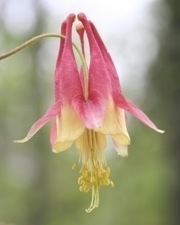 Those guilds already had rhubarb, strawberry, purple coneflower, yarrow, oregano, and self-heal. There are also volunteer pumpkins, potatoes back there and in the swale bed of comfrey and rhubarb I put in onions, tomatoes, and eggplant. I've got as much food planted as last year, all within 60 feet of my garden!
Those guilds already had rhubarb, strawberry, purple coneflower, yarrow, oregano, and self-heal. There are also volunteer pumpkins, potatoes back there and in the swale bed of comfrey and rhubarb I put in onions, tomatoes, and eggplant. I've got as much food planted as last year, all within 60 feet of my garden!
Last, but not least, the native wildflowers have all bloomed and look great: columbine, bee balm, jacob's ladder, wild geranium, purple coneflower with a few others to bloom soon.
Plenty of rain around here!
In about 10 days we've had over 20 inches of rain fall, 2 inches a day average! It's wet around here as you can guess. The geese are happy campers but the rest of us are ready for some dry time! Looks like most of the next 6 days is set to be sunny but two days have a chance of rain. Ugh. Both of our lake spillways have been running all out for the past 10 days, our bridge and lower road are washed out pretty bad. The other night I realized 2 of our kayaks were left to close to the water and when it came up they went out. I realized this when I woke up at 3:15 in the morning. So I ended up in the last kayak at 3:30 going across the lake with a flashlight in my mouth trying to find them. You don't want a pair of kayaks clogging up your spillway or the culverts under a bridge that is already washing out! Didn't find them but at least verified that they were not in the spillway. Found them the next morning at first light, one washed up on shore and the other in some brush by the dam. Close call. So, kayaking at 3:30 in the morning, 45 degrees with a bit of drizzel? Not recommended! And that was after spending 2 sessions in the lake Saturday and Sunday inspecting for leaks. Our dam has held up very well for the past 20 years and has weathered this recent storm like a real champ! We do have to do a bit of routine maintenance to take care of though. Dams need to be kept clear of trees but covered with grass or some sort of ground cover to protect the clay.
The hugelculture beds are coming along fantastically! Lots of kale, lettuce, spinach and chard in full swing with eggplant, peppers and tomatoes ready to go in once we get past this last cold snap. They handled all the rain really well and my plants are not at all water logged thanks to the elevation. Not only that but those buried logs must be full of water which will help keep the soil moist for many weeks to come. The food forests are all coming along, most notably the one just out my front door is really filling in perfectly with plum, currant, comfrey, lemon balm, yarrow and sage. All the blueberries have come up looking great too.
Our last construction project is nearly finished. The shower house is almost done with only the last bit of plumbing to do. The walls, shower, sink are all in and it's painted. We still have to paint the outside and then finish the upstairs loft where Jake/other guests can sleep. The red cabin is finally totally finished on the inside with a little kitchen sink and cabinets. There's a bit more to do in terms of an outside roof to keep the door dry and an extension on the back side covered area so that the full length of the backside is covered. After that we should be done for a while with construction stuff! Will be nice to spend more time relaxing rather than filling the weekends with constant work. There's still maintenance to do of course but it will be nice to not have air compressors, nail guns and saws constantly running in the background.
Oh, and an animal update. I've had the pleasant tweet tweet of 5 chicks in my cabin for the past 3 weeks! They are growing up fast and so cute with their first feathers in. Petunia is definitely pregnant and will be having her first fawn in the next 30 or so days. She's been around most days for a bit of corn. The two canada geese have also been hanging out by the font porch every day as well, a nice addition! In fact I'm looking at them both right now as they lounge around in my front yard. I love their personalities, mannerisms, and constant vocalizations.
Greening up fast!
It's been a couple weeks since I posted about planting the hugelculture beds. They're a carpet of green: lettuce, spinach, chard, radishes, onions and kale. Another week or two and I should be harvesting lots of salads! It will be interesting to see how well they produce, especially once I start adding in the bigger plants like tomatoes, peppers, eggplants and squash. The tomatoes, peppers and eggplants are doing great in the greenhouse with another batch started a week ago. The rhubarb is about ready for a first harvest and the comfrey already has flowers!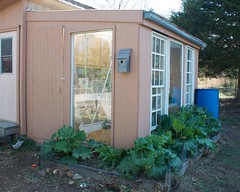 The food forests are also coming alive with fruit trees taking off as well as all of the perennial herbs: oregano, lemon balm, sage, thyme, yarrow, purple coneflowers, feverfew, and tansy. The blueberries, currants, serviceberries, gooseberries and pawpaws are also awake and growing rapidly. Last but not least, the hardy kiwi vines have really taken off and look great.
The food forests are also coming alive with fruit trees taking off as well as all of the perennial herbs: oregano, lemon balm, sage, thyme, yarrow, purple coneflowers, feverfew, and tansy. The blueberries, currants, serviceberries, gooseberries and pawpaws are also awake and growing rapidly. Last but not least, the hardy kiwi vines have really taken off and look great.
All of my native perennial wildflowers are also coming up and doing well a year after transplanting. Orange coneflowers, bloodroot, jacob's ladder, geranium, primrose, columbine, bee balm, cardinal flower and blue lobelia.
Last, I'm not a big fan of grass but late last summer we trenched in our water line from the well to the two cabins and the grass never reestablished so I've had LOTS of mud around here. We seeded it with a mix of grass, red and white clover, all of which is starting to rally take off. I'll be glad to be rid of all the mud!
Solar Air Heater!
The new solar air heater leaning up against the well/shower house where it will likely be installed as it is a near perfect south facing wall. Thermometer reading after just a minute behind the air outlet? 100 degrees and that's with outside air of 48. NICE! My guess is that this would easily heat our little shower house to a comfortable 70+ degrees on sunny days during the winter. A big thanks to Rick for building it!
Update 1: Went back out to get another temperature reading, 110 degrees! From what I've read online they can be expected to output air between 100-130 degrees or more on sunny days. Even on cloudy days they will put out air that will warm a space though obviously not as effectively.
Update 2: As of this update (1pm) it is 50 degrees outside and the current reading is 120+ (my thermometer tops out at 120) that's a 70 + degree gain.
So, cost on these, is 4x8 plywood, 2x4, paint, caulk, silicone, tempered glass assuming it is all bought new probably $100-150. My guesstimate is that in one winter the savings on electricity would be $300-500 depending on the use scenario. Cost on keeping our well/shower house heated to 50 degrees this winter has probably been $60-80, maybe more. To keep it heated to 75 for comfortable shower house temps would have been MUCH higher, easily $200+ as it would require an actual heater, not just the two heat lamps I currently use. Using the solar air heater, I think we'll be able to keep this structure heated to at least 75 on sunny days, for free next winter.
Getting stuff done: Hugelkultur beds and greenhouse bed
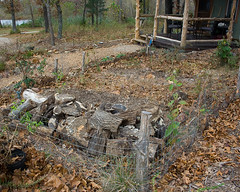 With questions about my residency I'd put a few projects on hold but now that it's all cleared up I've gotten back to work.
With questions about my residency I'd put a few projects on hold but now that it's all cleared up I've gotten back to work.
I doubt it is possible to mouse-proof a greenhouse but I did my best. Last year they ate up my greens, this year hopefully it won't be so easy for them. I put some semi-composted chicken bedding into the soil and got some kale, lettuce, spinach and chard planted. We'll see what happens. I've also stapled up the remaining bubble wrap on the inside ceiling for an added layer of insulation. Last, I've got the north side wall that is shared with the chicken coop stacked up with an internal straw bale wall. I'll also put bales on the east side. I noticed last year that while the water filled black barrels never froze up they also never gained any noticeable heat. Yeah, they were thermal mass but not warm. What I did notice though was that the straw bales that were in there warmed up really well. I figure it can't hurt and will likely help a great deal. I'll share data as the winter progresses. I'll keep one barrel inside filled for watering the plants.
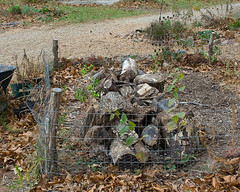 Next on the list, start the Hugelkultur beds in the little keyhole beds outside my cabin. For those that don't know, Hugelkultur is a form of raised garden bed using wood. This is especially important for me because the soil in this garden is contaminated with lead. Years ago this area was heavily mined and in fact the whole area is called the lead belt. The history of these towns is all based on the mining. Years later folk that probably shoud have known better but apparently didn't started using the tailings piles for roads, driveways and anywhere gravel, rock, or sand might be used. They used it around the lake on the roads and back in the 1970s and 80s they used it all around this place for the camp sites. Not smart. I could have them come in and take out the soil but frankly it is a huge mess and I don't necessarily trust the "soil" they bring in to replace the bad stuff. There's certainly nothing fertile about it as it is the brightest red clay you'll ever see. So, my intent is to build keep these beds raised high above the ground level, contaminated soil. I'll just rebuild them every couple of years until I've gotten several feet up.
Next on the list, start the Hugelkultur beds in the little keyhole beds outside my cabin. For those that don't know, Hugelkultur is a form of raised garden bed using wood. This is especially important for me because the soil in this garden is contaminated with lead. Years ago this area was heavily mined and in fact the whole area is called the lead belt. The history of these towns is all based on the mining. Years later folk that probably shoud have known better but apparently didn't started using the tailings piles for roads, driveways and anywhere gravel, rock, or sand might be used. They used it around the lake on the roads and back in the 1970s and 80s they used it all around this place for the camp sites. Not smart. I could have them come in and take out the soil but frankly it is a huge mess and I don't necessarily trust the "soil" they bring in to replace the bad stuff. There's certainly nothing fertile about it as it is the brightest red clay you'll ever see. So, my intent is to build keep these beds raised high above the ground level, contaminated soil. I'll just rebuild them every couple of years until I've gotten several feet up.
Hugelkulter is not hard to explain but I found this excellent post that does the job well:
Hugelkultur: Using Woody Waste in Composting:
Hugelkultur is an ancient form of sheet composting developed in Eastern Europe. It uses woody wastes such as fallen logs and pruned branches in order to build soil fertility and improve drainage and moisture retention.
If you walk through a natural woodland, you will see many fallen logs and branches on the ground. The older these logs are, the more life they sustain. A log that has rested on the forest floor for five or ten years will be covered in moss, mushrooms, wildflowers and even young trees. Poke at it a little and you will notice that the decaying wood is damp in all but the most vicious of droughts.
Hugelkultur is designed to take advantage of the natural fertility and moisture-conserving qualities of rotting wood, while speeding the process of decomposition up. The heat produced by decomposition also helps protect cold-sensitive plants.
In the photos above you can see I've got the semi-rotted wood hauled in and ready to be covered with straw, chicken manure, the last several scoops of wood chips we have. That wood is stacked up about 20 inches. I've got some good soil from our old wood pile (where this wood came from) and will just wheel barrel it down and add for the top layer. It's great stuff full of the rotted bark of lots of logs and is not contaminated. The final beds should be 24 inches above ground level. I'll post photos of the beds when they are completed. These will absorb water all winter and in early spring will be like water filled sponges. The decaying wood will rob the soil of nitrogen so I'll have to fertilize these beds heavily with chicken manure but I think it will be good and is certainly better than digging and growing in contaminated soil.
Early Fall
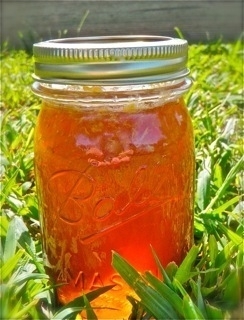
I've really been enjoying the sustained cool weather of late summer. I'm trying to get caught up on my winter firewood. I should get it chopped in spring and early summer so it dry out all summer but coming off of winter I'm usually chopping wood daily for the next day and getting the spring garden going so I once the weather warms I've had my fill of chopping and put it off. Right now it's not a big problem as much of the wood I have has been down for a few years and seems to dry pretty darn fast once I've chopped it up and gotten it covered. In the next couple days I should be able to get enough wood done to last me through December. If the weather is good over the next week or two I should be able to get enough done to get me through January or February. I actually don't mind chopping in the winter as it is the only exercise I get and it warms me up on a cold day... as the saying goes, wood warms you up twice.
Aside from the wood I'm slowly working through the jungle of weeds that the summer garden became when I gave up on it. Putting them as a big layer of mulch out around the blueberries so they'll compost into the soil. There is no doubt the soil around here has been greatly improved over the past two years. So much looser and full of earthworms and nutrients... yes, I'm very happy with the soil! Really, that's what I love the most is the soil. I enjoy gardening but I love enriching the soil and digging my hands into it. I'll probably cover the garden this fall with lots of cardboard and straw which I did not do last fall or spring, hence all the weeds. As I said recently I don't plan to plant the garden next year. I'll just let it sit and rest. The real problem is it is way too big for one person.
Next big outside project is to get any rotten wood hauled up into the small garden to start the Huegelkultur process. Next year I'll focus on a smaller area and see what I can produce. I think I'll be alot happier. Other than that we've got to get the new well house built and I've got to get my new waterline winterized. Oh, yeah, I've got water straight from the well now! I don't think I mentioned that before. So nice to turn on the faucet and have cold, drinkable water! That luxury will make living here in the winter so much easier!
Bees and chickens, chickens and bees. I don't know if I want to keep the bees. I hate to give up on a project but I just don't know that I want to keep them and am leaning towards selling them. I spent a good bit of time this past fall and spring keeping them well fed with sugar water. I did everything (almost) by the book and had such an amazing healthy hive back in March only to have it split twice and end up with a fairly small hive that hasn't produced much in the way of honey. We got one good, full frame which gave us two pints of beautiful, sweet honey. The remaining frames are only partially pulled out and capped. Not counting the equipment investment, I probably spent $15 in sugar... those are two very expensive pints of honey! You could argue that the cost of the boxes, if spread out over 10 years is a good investment but the sugar water is something that has to be fed ongoing. On the one hand I do love certain aspects of bee keeping but I'm not sure it is enough to keep them. It's a project that only gets bigger and more time consuming as the hives grow and split and grow and split.
The chickens have been another frustration this summer. The egg harvest went way, way down and really I was/am confused about what the exact cause was. Part of the problem was my own doing I think. Somehow I missed the lesson about the importance of calcium in their diet. I knew they needed it and had been feeding them their ground up egg shells. I did not realize just how important it was though and didn't know that I should probably also be feeding them oyster shells. I did notice their shells were not real strong and then a funny thing started happening. Egg production started to decline back in June and I also started noticing eggs with just a membrane or in some cases no shell at all. They would just sort of lay a blob of egg. This was happening at the same time that black snakes moved in and started stealing eggs. I think I captured at least 8 in July and August. But because of the snakes I didn't realize that they were starting to lay fewer eggs. Add to this mix the fact that I caught the hens themselves eating a few eggs and I've got at least three or four variables/explanations. As of the past two or three weeks I've been lucky to get 2-3 eggs a day from 11 hens.
While I do adore my girls I don't keep them as pets and I want to be able to sell enough eggs that they at least pay for their feed. I've been feeding them oyster shells for a month and am hoping that helps with the soft shell and reduced egg laying. In a way it may be a good thing that they are taking a break from laying because I'm seeing that they are getting their feathers back. Now that I've got their diet fully rounded with the calcium source I'm hoping that perhaps we'll go into the fall with fully feathered, rested hens that have a more balanced diet. I feel terrible that my ignorance contributed to them not being as healthy as they should be.
All in all it was a difficult summer but we've made real progress. A covered porch, running water, renovated interior in the red cabin, lots of new perennial garden beds and no major losses. Kerry and Greg and the kids will be able to spend alot more time down here thanks to the red cabin remodel so that is good news. In theory the work done this summer should make for more frequent and more comfortable visits for my folks as well since they stay in the red cabin too. The next big project is a porch for the red cabin which we should be able to knock out in a couple weekends next spring. There's a good bit of perennial landscaping I'd like to do around the cabins next spring but nothing too crazy. Next year should provide lots more time for enjoyment and less time with construction.
The Gulland Forge Broadfork!
The UPS guy showed up a little bit ago to deliver my new, hand-made broadfork gifted to me by Larry Cooper. He makes them by hand and let me tell you, what an awesome tool. The ash handles had a really nice smell thanks to the linseed oil/turpentine finish and I pushed them into the metal fork assembly. It was then that I noticed the engraving "Our Tomorrow" which, honestly, brought a tear to my eye. Just when I thought such a gift could not possibly get any better there is that thoughtful detail. Larry: THANK YOU.
I've not had a chance to use it much yet as I was eager to post this. But I DID use it a bit and wowza, this is one fantastic tool. It just works, like an extension of the body. I stepped on to the center of it and my weight pushed it into the earth and then I just gave it a gentle rock back to loosen the soil. I can't wait to work some beds with this! Everything about it from the handles to the tines just feels so solid. America needs to return to this kind of hand-made quality.
Will post more when I've had a real chance to give the broadfork a real workout!
Gulland and his Broadfork Blog
After yesterday's post I got a comment from Gulland offering to send me a gardening tool that he makes. He didn't mention what it was so I went looking at his blog and found that it is called the broadfork. I've heard of this tool but never used one. From what I read it is used to replace the tiller and is kinda like a very wide pitchfork to loosen/till the soil. I don't generally till as I prefer disturbing the soil as little as possible leaving the soil community intact but I do use a sorta modified double dig method on my beds when I first set them up which lossens the soil 1-2 feet down resulting in a raised bed of loose soil 2-3 feet in depth. It seems this is the perfect tool for that as well as for loosening the soil every couple of years. Not only does it not use oil but I'd guess that it is a much more gentle process in terms of disrupting the layers of the soil. I think it aerates the soil without turning the layers, thus adding oxygen and improving the soil structure without destroying the soil community. That it is human powered is very important given our current climate, peak oil situation. Here's Gulland's blog post reply to a gardener named Tom and I thought I'd post it here as it addresses the issue perfectly:
Tom told me that he never even cranked his rototiller this year; he did it all with the broadfork he got last year. He also said that he would never have to use the rototiller in any of those beds again.
That's heavy stuff to me; I have created a business that provides an implement that allows people to step back from the use of fossil fuels to do the 'heavy lifting' in their gardens. Because of my broadfork, there is one less rototiller running in California this year!
Tom, I have to say that your email and photos have made me know that I am doing the right thing. Thank you for turning the lights on for me.
I am an Alabama native, and lived my first 42 years there. The Gulf of Mexico was in my backyard, and I loved visiting that coast.
The point of this blog was to inform people about the utility of the broadfork and give some insight into the man that makes them. I never wanted to be political, or controversial. I must say, however, that the disaster that has occurred with the deep water drilling platform in the Gulf of Mexico has made me feel that any time I can steer someone away from the use of fossil fuels to good old fashioned hand labor, I have done a good thing. The reason you are reading this is that you believe the same thing that I do.
We need to lessen our need to use petroleum products. The low hanging fruit has all been picked, and the rest of the crude oil that is available is in the inhospitable places where it is probably best to just leave it alone.
When I've had a chance to try it out I'll be sure to post a review. If only I'd had a tool like this over the past decade or two I might have fewer back problems!! A big thanks to Gulland for getting in touch and for his generous offer.
Opps, edit. I did some more reading and wow. Gulland is not only building a great tool but the way he does it is a fantastic example of building the local economy. In these times of rising unemployment and a job market dominated by meaningless jobs at Wal-Mart and McDonalds, Gulland is creating a useful tool from scratch! Read more in this post on his blog.
Growing and eating local food
It is raining here this morning which is something we really need. As I recall we had about a quarter inch of rain in June and May was fairly dry too. Not only that but daily temps in June averaged 4-5 degrees above normal, above 90 most days in June. Very hot, very dry and not an easy month for gardeners! So far we’ve had just over an inch in the past two days, maybe 1.25 and that’s not enough. We could easily do with another 5-7 inches, preferably spread over a week or so! My rain barrels have filled a bit but have a long way to go and the swale has yet to show any signs of filling. Looks like we’ll get a good bit today and then they say a good chance of rain much of next week with temps at or below 90 so that is welcome news. Lesson learned this summer? Heavy mulch will only do so much to retain moisture. No doubt it is a huge help but things DO eventually dry out!!
So, the garden looks pretty ragged. The potatoes and tomatoes in particular. One bed of tomatoes look okay but the other two have struggled. I planted onions and lettuce in those beds in early spring with the intention of having a nice living mulch and it did not work out so well. Back in late March/ early April not long Ifter I got my lettuce, spinach, carrots and other cool weather crops planted we had a pretty nasty hot spell and weeds started popping up everywhere. The end result was that the beds of annual green veggies I envisioned were heavily mixed with LOTS of weeds and not nearly thick enough to really serve as a mulch for the tomatoes which got planted in later. The tomatoes which I mulched with newspaper and straw is, by far, the best of the tree beds. Next year I’ll go back to the paper/straw mulch and just plant the outer edges with basil and flowers.
I got my squash in a bit late and that was another mistake. With the exception of a couple lost most survived the heat and are growing but they are not thriving. The watermelon volunteer that sprouted up early is doing great and has taught me that next year I REALLY need to get my squash/melons started earlier. In fact, really, I think I need to get EVERYTHING started about a month earlier. All that said, I do have better potatoes than last year and a nice bed of carrots and I had a great harvest of sugar snap peas. The blackberries that I left out in the food forest by the chicken forage have done great this year and I’m really glad I left them when I set up that area. I’ve been harvesting many big handfuls everyday. I probably could have set some aside for preserving but have just been eating them up! Further out from the cabin I know the blackberries are producing gobs of fruit so I really should go out and gather some.
Last would be the food forests and they are doing pretty well considering the drought. Blueberries, currants, gooseberries and pawpaws are doing great. I’ve got gobs of comfrey I need to get put in the ground and am going to give the last few rhubarb plants to Karen. I think I’ve got 12 rhubarb plants in the ground now. Yeah, that’s a crazy amount of rhubarb but it is a beautiful plant and fairly easy to grow. I’ll give or sell what I can’t eat! I’ve planted it with Comfrey around the greenhouse and in the food forest behind my cabin.
One last thing, not about the homestead but about the local farmers market: fantastic! I went last night and came home with a bag of sweet corn gifted by Karen and David (THANKS!!) as well as a loaf of Donna’s yummy home made bread. Also a very nice cucumber and some peaches. Dinner was a cucumber tomato sandwich, two of those actually and 4 cobs of sweet corn. I don’t cook the corn or add anything at all, just peel and eat!! I’m surprised more people don’t eat it that way. It doesn’t need to be cooked and is so sweet and juicy. Yeah, the corn was desert. Oh, oh and a big glass of iced Kombucha too thanks to Juli. It took 10 days but the fermenting tea is now a perfectly fizzy and tasty treat. The perfect meal to eat while enjoying the soft patter of rain on the roof.
Homestead Life and Death
It's been a couple weeks since I posted a homestead update. I've had my first chicken deaths by predator. Just over a week ago I lost two of my girls, I think to a fox. Whatever it was came out just before dark before I'd put the girls in for the night. I've since been very cautious. Putting them up earlier and making more frequent trips outside to make my presence known during the day. I've also been playing music during the day in the hopes that it might be a bit of deterrent. Towards evening when the original incident happened I've made it a point to be out doing a project in the garden or near the coop. With this hot, sticky weather I'm always more likely to be working in the evening anyway.
I've also discovered why I was seeing a decline in egg laying: the girls are laying as usual but a big black snake had taken up residence deep in the straw bedding of their coop. I shoed him out once but he's back. I'm going to try to catch him in a pillowcase and relocate him. It took a full year before I had a black snake messing with the coop so I'm hopeful that if I can relocate him perhaps I'll have another year without another.
My comfrey has really taken off this year and I'm getting a good harvest which is going into five gallon buckets for brewing into a potent comfrey tea. After 7-10 days the leaves have transformed into a stinky green slurry full of nutrients. This can be applied as a foliar spray or watered into the roots. I've also got a bucked of chicken manure tea that will be watered down and used after a couple of weeks, probably on the comfrey and tomatoes.
The garden is coming along with everything planted at this point. The peas finally gave up but I got a good crop out of them. After a slow start I've gotten gobs of lettuce though it is now starting to bolt. The carrot and onion crop is looking really good. The squash and watermelon are looking great and have blooms. I was a bit late getting my pumpkin seed in but better late than never! I've potted the eggplant up and have them closer to the cabin. Last year the eggplant plated in the garden was decimated by flea beatles so I'm hoping to control that by potting them and keeping them closer. So far so good. The perennial borders are starting to fill up with coneflowers and feverfew with the gaps filled in by annuals such as zinnias. The tomatoes are coming along and the basil seedlings are starting to take off.
I've gotten my first harvest of rhubarb and will get a good bit more this year. The rhubarb seedlings started this year are doing fantastic but I won't harvest them till next year. I've still got more rhubarb to get into the ground as well as 18 comfrey plants. I may end up selling some of the comfrey at the farmers market. Last but not least, the Hardy Kiwi is growing very well and has, in this second year, already reached the top of the garden entry arbor. I have little doubt it will completely cover the arbor by the end of July given the current rate of growth. It is a beautiful vine!
It's been a very hot June with temps way above normal. I'd really love some rain and a cool-off!!
Geek Gardening: A Wired Guide to Domestic Terraforming
I was browsing through my RSS feeds this morning and come across this fantastic article in Wired which is basically about permaculture though they don't use that word. Instead they discuss gardening as a process of careful design described as terraforming... essentially, permaculture. Excellent color design diagrams ranging from small gardens on apartment terrace or big garden spaces in a suburban or rural setting. If you are the least bit interested in taking gardening to the next level this is really worth a look, a great introduction and a nice surprise that it came from WIRED!
Swale and Food Forest Update
Last year I put in a swale and food forest on the north and east sides of my cabin. I planted the swale with comfrey, rhubarb, juneberry and yarrow with space between for annual veggies. This spring I seeded it with radish, chard, broccoli, kohlrabi, and cabbage. I'm pretty happy with the results thus far. The comfrey and rhubarb have filled it nicely and the veggies are going great in the swale. Now, if only we'd get some rain. Been a pretty dry spring. In the past 6 weeks we've had maybe one really good rain fall. The five rain barrels have come in very handy though they are nearly empty!
The pawpaws and juneberries are doing great. Well, Petunia has nibbled the juneberries so they're not great but would be were it not for her. She's left the pawpaws alone and they are growing very well. The herbs growing around the pawpaws, a mix of yarrow, self-heal, oregano, lemon balm and coneflowers are also growing pretty well. I've got some strawberries I'm about to put in though I'll have to put some chicken wire over them to protect from deer and chicken. I'd put them in the main garden originally and they were doing fantastic but Petunia got to them and ate ALL of the foliage. Soon after they were taken over by weeds.
One key difference between the food forest and the kitchen garden is that the food forest seems much less prone to weeds. I think the reason is that, while in a sunny pocket, this area has mostly been wooded and the mix of foliage here is much less aggressive. The kitchen garden by contrast is located in an area that has been an open field for the past couple of decades or more. Any bare spot of soil up there quickly sprouts up with "weeds". I'm thinking the strawberries will do much better over here. The key will be keeping them protected with the chicken wire.
One other key to this food forest area is the combination of light and heavy mulch. This pocket of woodland gets full sun most of the day with just a bit of dappled shade. That combined with the heavy wood chip mulch and leaf litter has really helped with the water retention. I've also got lots of big bark chunks from chopping wood that I place around the little trees. It helps discourage the chickens from scratching to close to the trees and holds in the moisture. The fertility of the soil is also being improved greatly I think. At the moment the chickens are back in the fenced forage area but they've been free ranging for the past ten months or so and have stirred and pooped in the food forest mulch that whole time. Next on my to-do list in this area is to add in more low level herbs to begin filling it out.
Lots going on...
In the past couple of weeks we’ve had lots of progress with a variety of projects. The cabin finally, really feels complete. The porch is my favorite place to be which is what I fully expected. I added a new flower bed and have put in rock creek paths to replace the composted mulch which was raked into the flower beds. The garden beds in the area immediately around the cabin (Zone 1 in permaculture terms) are shaping up pretty good. Lots of lettuce, chard, kale, kohlrabi, cabbage and radishes as well as perennials such as rhubarb and comfrey. The flowers too are starting to take hold with blooms. The last touch was moving the little garden pond from it’s somewhat neglected location to a spot just a few feet away from my porch. Frankly this little corner of the world is starting to resemble a moment or scene in a storybook which is what I’d hoped for.
Other projects that have been tidied up or finished include the new fire ring which also got a thick layer of rock creek gravel. The kids cabin is fully painted and trimmed with the last bit of deck finished. In the main garden the crop of onions, garlic, and peas are fantastic. The potatoes are looking great. Two beds of tomatoes planted and looking good with another bed to go in soon. Still to do, transplant or sell my remaining rhubarb, tomato, and comfrey seedlings. I also need to get the basil planted as well as melons and pumpkin.
The chickens have been spending their days in the lush chicken pasture that I prepared this spring and they seem to be pretty happy with it. I miss having them free range and do intend to let them range for a couple evenings a week but they will be spending most of their time in the pasture as long as it is holding up. I won’t let it get run down to the same point as last year. While it was sometimes somewhat problematic I really miss having them in close proximity to the cabin.
It’s gonna be getting hot and humid soon so I’m going to go crank out a few loads of laundry. Have a good day!
Covered Porch Progress!
Deck, cedar poles, and rafters ready for metal roof. Steps and railings have been added in this photo. The Deck is salvaged from an old deck that has been in use on various other structures for at least 20 years. The rafters were salvaged from yet another deck and the cedar logs were from tornado damage as well as a few selectively harvested from a grouping that desperately needed thinning. The metal roofing will be added soon and is the only thing that will be purchased new.
In this image you'll notice that some of the logs have had the bark removed, others have not yet been cleaned up. I actually prefer the way they look with the bark but that usually means that insects will get in and when the bark eventually does come off (which it will after a couple years) it will likely have a bit of damage in the form of small grooves. By taking off the bark now the logs will be a bit nicer in the long run.
I'm very happy to have this up before the heat of summer kicks in because I rarely use the air conditioner. I think last year I used it maybe three days. That is a south facing wall so having the porch should really help keep the cabin cool as it will completely shade the area in front of the door and that south facing wall.
First Salad!!
Harvested my first bit of lettuce and spinach Wednesday night and it was so tasty!! There’s nothing quite like eating salad that was picked 5 minutes before eating. I’ve got an okay crop of greens coming in though it’s not as thick as had hoped it would be. I planted it pretty dense but we had such a warm spell back in late March/April that I think it stunted things a bit and gave a head start to the weeds that were plenty happy to have the warm weather! In any case, nice to have fresh salad!
I’ve also started harvesting strawberries from the plants donated by friend and fellow Fredericktown Revitalization member Juli. I probably won’t get many this year but the plants are healthy and should produce very well next year!
New Natives
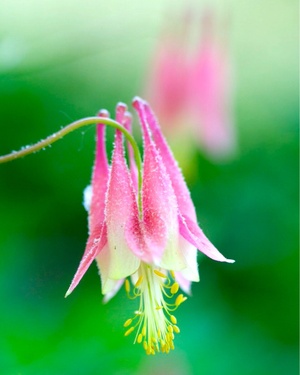
Lots of planting the past couple days. Saturday I picked up some ferns, hostas, Russian Sage, and Catnip from my aunt. The ferns come from my great grandmother and have been passed around the family for years. They are beautifully lush and spread quickly. They’re also quite large, some of them reaching a height of 5 feet. I’m not sure what kind they are but I planted a row across the front of the cabin and can’t wait for them to fill it in hiding the base of the structure during the summer and softening the lines. Then I picked up a whole bunch of native wildflowers: Columbine, Jacob’s Ladder, Bee Balm, Purple Coneflower, Orange Coneflower and Black-eyed Susan most of which was planted into the shade garden in front of the cabin, in front of the ferns. Some of them were planted in the new flower border that lines the northern fence of the garden.
I probably planted 150+ plants in the past two days. When they all fill out, probably by the end of next summer the planted areas will be about full. I don’t cut the flower heads in the fall because the gold finches and other birds will eat the seed. The seed they don’t eat will fall and germinate. By the spring of 2012 I’ll have more plants than I can use and will be able to pot them up and sell them. The plants originated at my parents' house which I planted in 2004-2005. The plants there are now multiplying exponentially. Thousands of seedlings now cover the area and serve as a growing nursery. I’ll probably go back for another batch of transplants in early June though I don’t really need to.
The Garden Grows!
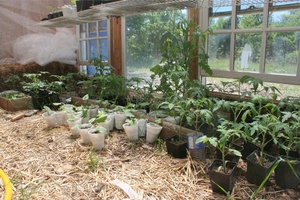
It’s been slow going this spring, or at least it seems that way. I am impatient. The onions, peas, potatoes, strawberries and various greens are looking pretty good. I think I should have planted my greens (lettuce, spinach, chard, etc) a week or two earlier than I did. The greenhouse is full of plants that will be ready to plant out pretty soon: tomatoes, peppers, eggplant, comfrey and rhubarb. Unfortunately my tomato varieties got all jumbled up so while I know what I planted I have no clue which is which. I’d thought I might sell a few plants at the farmers market but I’m not sure that folks will want to buy if they don’t know what variety they are getting. I’ll just call them all “Denny’s Great Tomatoes”. 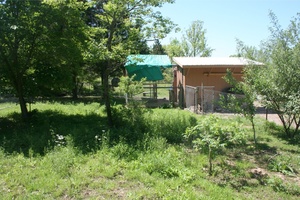
In other green news, the last year’s chicken pasture is really looking good! With the exception of a couple of spots it is now a lush polyculture with a base of red and white clover. Other notable species: comfrey, self-heal, yarrow, violets, daisies, plantain, and honeysuckle. There’s far more but those are the most numerous. Now that the chickens are free ranging I’m not in any kind of hurry to open this back up. I’m going to give it another week or two for the clover to grow a bit more and then I’ll start leaving the gate open for chicken browsing. Th peach tree and apple tree in this area are both looking fantastic.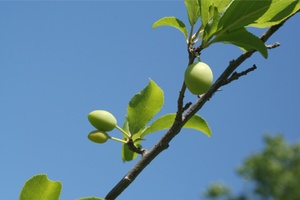
Speaking of fruit trees, we now have plums, apples and blueberries coming in. Pictured here are some of the plums. I need to learn about proper fruit tree care. Should I have clipped these off to promote more growth this year? These are still pretty small trees. Also, I know they need major pruning. Their rate of growth is taking off but in terms of the shape of the growth, they are a huge MESS. Assuming no major natural disasters the trees, bushes and vines should all be putting out a really good crop in the summer of 2012. The currants, gooseberries and blueberries will probably be producing pretty good as early as next summer. I can’t wait.
Swarms and Other Homestead News
B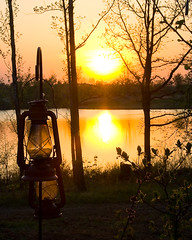 ees
ees
Just a few days after my last post my bees swarmed! Luckily Greg was down that weekend and was able to retrieve the cluster from a cedar. We moved them into the honey super that I had on hand and then moved the super of bees several hundred yards from the original hive. All seemed well till the next day when they swarmed again while I was gone. When I came out to inspect the new hive the air was full of bees and they were in the process of flying away. There was nothing I could do but watch. The only thing I could have done differently (that I’m aware of) was to enclose the bottom entrance of the hive more completely as I’ve read many people do when creating a new hive from a swarm. The problem with that was we were so hot last week I was afraid to close it more than 80%.
So, that was a bummer. I still have the original hive which is still a very nice, healthy hive and I’ve got the honey super on. Still waiting on the two I ordered to arrive. My hope is that I’ll still get a good harvest of 2-3 honey supers. I’ll be picking up another couple of deep hive bodies and hope we’ll be able to successfully split the hive next year via a caught swarm or pre-swarm split. 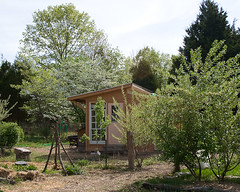
Garden
The garden is slowly waking up. The onions, sugar snap peas and potatoes are looking good. The lettuce, spinach and a few other cool weather greens are slowly getting there. I think the week of crazy warm/hot weather did not do them well. I watered a good bit this past weekend as we’ve not had rain for over two weeks. The tomato seedlings in the greenhouse are looking pretty good. I’m eager to sow the fence borders of flowers like cosmos, zinias and a few perennial herbs such as feverfew but I was waiting for the past few days as we had some pretty chill night time temps. The rhubarb seedlings came up great and were just transplanted to pots. I’ll likely sell or give a few of those away as I have far more than I need. Strawberries, blueberries, currants and gooseberries are all doing great. Two of the hardy kiwis look fantastic and two died for some reason, no clue why. I’ve lost three fruit trees also not sure why. One was a bit flooded, the other two I don’t know. The comfrey seeds are coming up now. I planted 30 or so and will be transplanting them out around the fruit trees.
I’ve been nurturing the original forage area used by the chickens last summer. It is now full of red and white clover, yarrow, self-heal, and comfrey just to name a few. It is well on the way to being a lush polyculture of nutrient accumulating plants that will provide a food source for the chickens as well as our pollinating insects.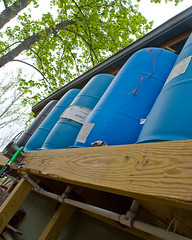
Water Harvesting
I finally finished off my rain barrel system. Five barrels behind the cabin will collect up to 275 gallons of water! There’s another barrel to collect water from the greenhouse roof. I may paint them at some point but plan to try growing ground nut or some other food producing vine first. They’re not real pretty to look at so I want to do something to pretty it up a bit, growing food on them would probably be the best choice. Some folks were wondering if this was for drinking water and the answer is no. I’ll use it mostly for the garden in the area right around the cabin. Also for washing my hands or for the critters to drink. It is fairly clean though and I probably could drink it if need be. I filter it at the inlet with a screen. There’s probably a bit of minute grit from trees and wind making it in. I suppose worst case scenario is a bit of bird or critter droppings from the roof and I do have the wood burning stove so the first few rains of spring probably contain some sort of smoke/soot type contaminates. If I were going to drink it I would run it through some sort of filter and would feel pretty safe with it. The barrels previous use was food grade flavorings with the exception of one that had concentrated hydrogen peroxide. They’ve all been very well cleaned.
One last bit of news, the kids' cabin is finally finished! Greg came down this past weekend and finished off the soffits, trimmed, caulked and painted. They’ll likely repaint the trim with a different color but for now it all has at least two coats and is safe from the weather.
Technorati Tags:
Cabin, Chickens, Conservation, Ecological Landscaping, Edible Forest Gardening, Edible Landscaping, Food, Food Forest, Food Production, Forest Gardening, Fresh Water, Gardening, Homesteading, Honey Bees, Living Simply, Missouri, Natural Resources, Permaculture, Self Reliance, Water Harvesting
